Have a look at this beautifully drawn 4-panel comic strip; see how long it takes you to identify what company is being advertised.
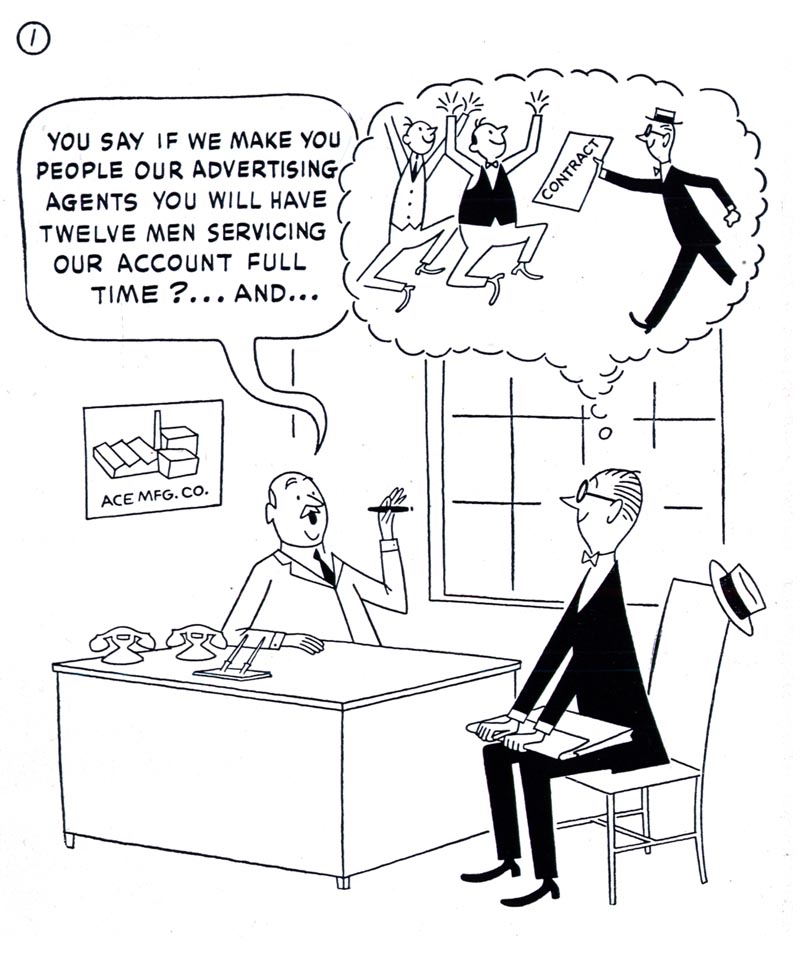
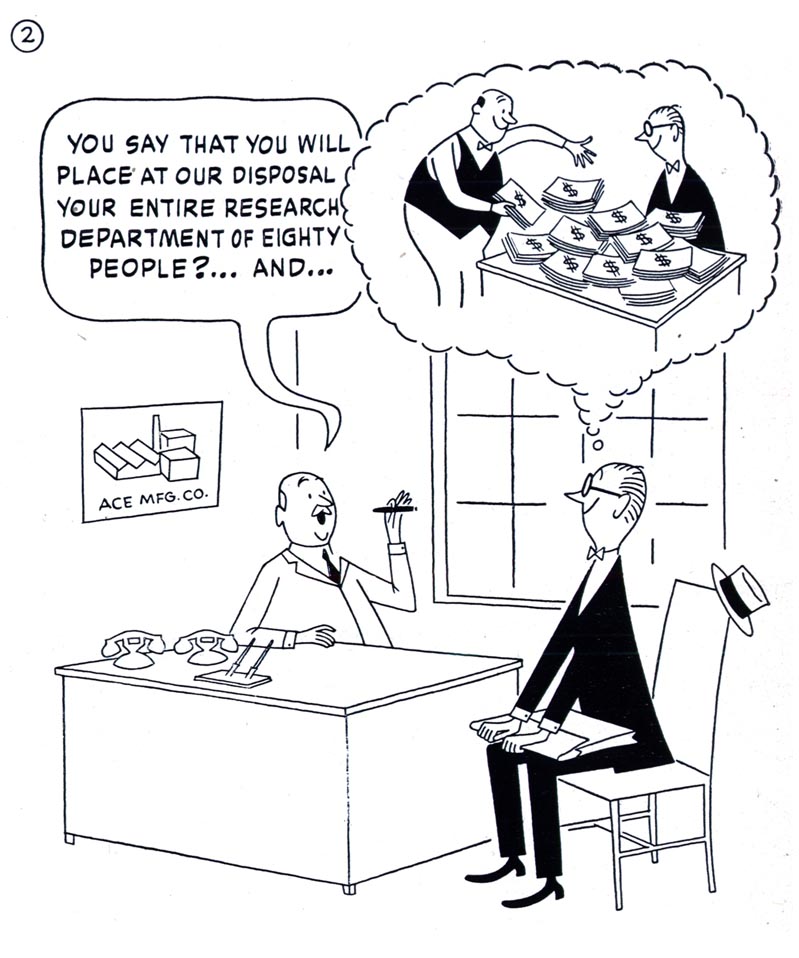
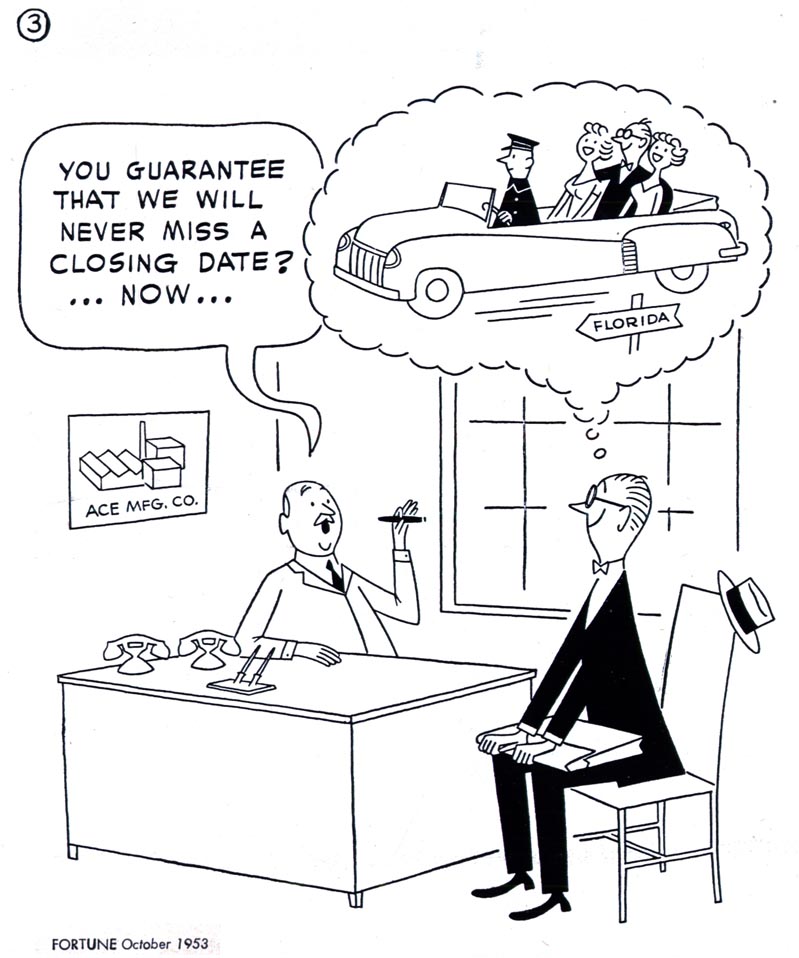
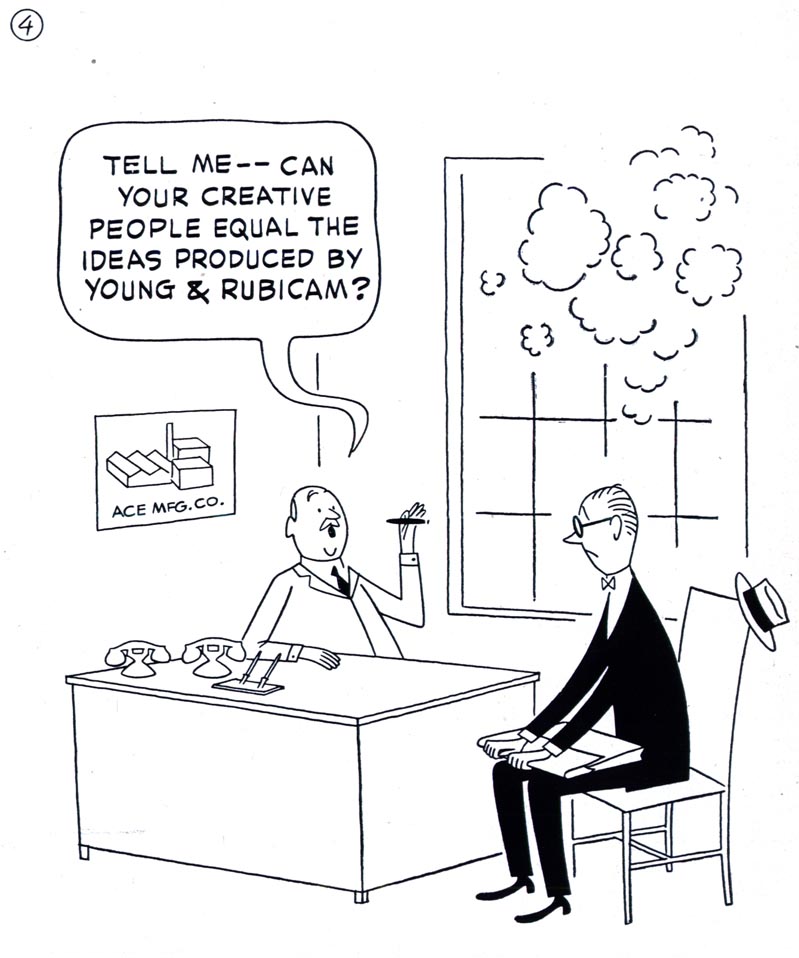
Talk about subtle. And not even a logo or tagline in sight!
For several years during the 1950s, the Young and Rubicam advertising agency ran ads like these, featuring cartoon art, in Fortune magazine and in the back of each year's New York Art Directors Annual.

Ever since I first saw them I've had been intrigued by Y&R's commitment to these unique cartoon ads -- curious about what had been their motivation in utilizing this distinctive approach. Recently, while corresponding with my friend Bill Peckmann, it all suddenly became perfectly clear.
In passing, Bill wrote, "While I'm thinkin' of it - it seems that some of the great cartoonists, Rowland B Wilson, Tom Yohe and Jack Sidebotham (Bert & Harry, the Piels Bros. Beer designer) were all art directors at the Y&R Advertising Agency in the '50's. (I know there are more names but they're not coming to me right now.)"

Bill continued, "There must have been something in the water there or the agency had a style at that time where they only hired art directors who could draw."
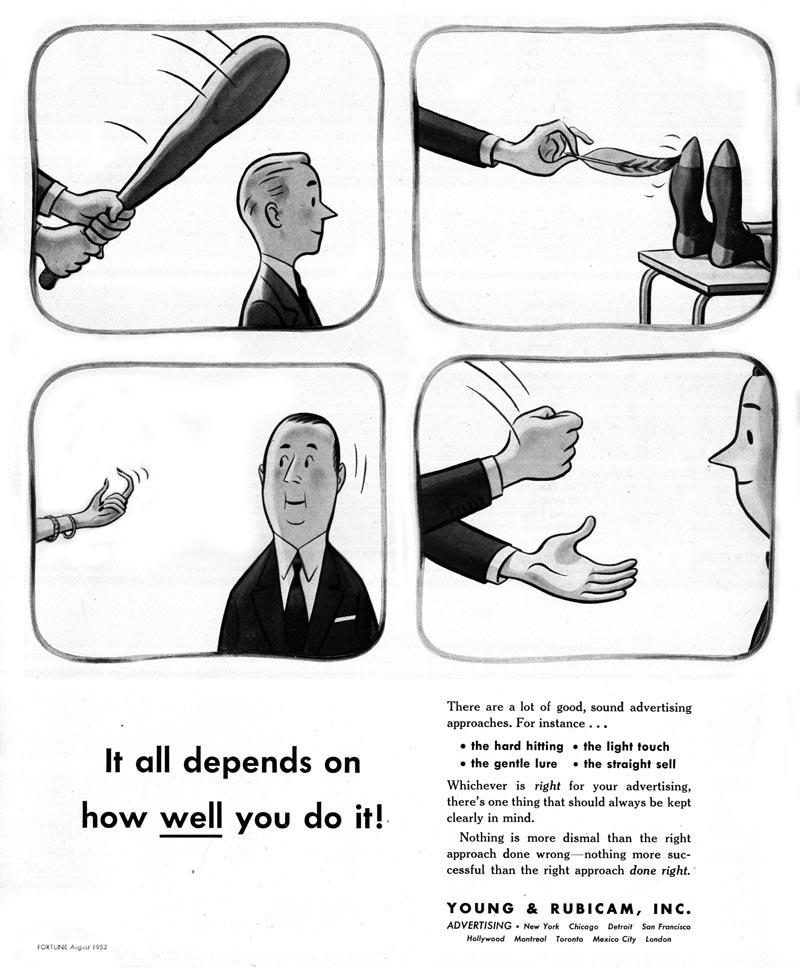
Imagine that: art directors who could draw... no wonder the folks at Y&R were so committed to running ads featuring great cartoon art. They could relate because they were cartoonists themselves. I wonder... are there still art directors who can draw? Or is that one more reason why illustration has all but disappeared from advertising.
Maybe today's art directors simply can't relate to the drawn image because they have no tangible connection to the act of drawing.




Talk about subtle. And not even a logo or tagline in sight!
For several years during the 1950s, the Young and Rubicam advertising agency ran ads like these, featuring cartoon art, in Fortune magazine and in the back of each year's New York Art Directors Annual.

Ever since I first saw them I've had been intrigued by Y&R's commitment to these unique cartoon ads -- curious about what had been their motivation in utilizing this distinctive approach. Recently, while corresponding with my friend Bill Peckmann, it all suddenly became perfectly clear.
In passing, Bill wrote, "While I'm thinkin' of it - it seems that some of the great cartoonists, Rowland B Wilson, Tom Yohe and Jack Sidebotham (Bert & Harry, the Piels Bros. Beer designer) were all art directors at the Y&R Advertising Agency in the '50's. (I know there are more names but they're not coming to me right now.)"

Bill continued, "There must have been something in the water there or the agency had a style at that time where they only hired art directors who could draw."

Imagine that: art directors who could draw... no wonder the folks at Y&R were so committed to running ads featuring great cartoon art. They could relate because they were cartoonists themselves. I wonder... are there still art directors who can draw? Or is that one more reason why illustration has all but disappeared from advertising.
Maybe today's art directors simply can't relate to the drawn image because they have no tangible connection to the act of drawing.
I have heard rumors.... but have never actually met that Mythical beast.
ReplyDeleteSomeone told me Unicorns were real too......
LoL - and that's coming straight from the horse's mouth, folks. (Jeff worked as an in-house illustrator at Y&R in the '90s).
ReplyDeleteThis comment has been removed by the author.
ReplyDeleteThat image you sent out with the email--The guy about to be clubbed in the head--At first, I thought is was by Rollin McGrail. I had her illustrate a Dobie Gillis story for me in the '90s, for Nick at Nite's 10th Anniversary one-off magazine.
ReplyDeleteIn the 1980s', Y&R San Francisco was at the verge of potentially loosing their largest accounts.. Chevron Oil Company. Every large agency on the west coast was pitching it, and they were making heavy financial and time investments to win one of the largest accounts west of the Mississippi. Y&R sent an award winning C.D. (Creative Hot Dog) from Australia to S.F. to head up the S.F. creative team. He asked for portfolios of the top storyboard artists in the area, and there were quite a few of us. He chose one illustrator that wanted to work with as a freelance resident for several weeks. I was called in for an interview ,along with several other illustrators, and he chose me for the project that averaged 14 hours a day for two weeks. The last day for me ended at seven in the morning. What had caught his attention about my portfolio was a storyboard I did in full color gouache on illustration board. They were loosely painted comps with the impact he was looking for. Most of us were using markers for storyboards and comps, and acrylics or dyes for finished illustrations. I did all the Chevron storyboard illustrations in gouache 7"X10" on illustration board. He felt it would make our presentation more unique and memorable. They all required very difficult drawing and perspective solutions to create an illusion of exaggeration and fantasy. Bottom line is that Y&R kept the account and I cemented a very busy relationship with the younger A.D.s at Y&R after that. The fact is that as Leif alluded to, by the 80s' more and more major agency A.D.s couldn't draw very well, which actually helped keep me busy as a freelance illustrator. They needed seasoned illustrators to create visuals of their ideas. It became a team effort which was a win-win for both of us.
ReplyDeleteTom Watson
Oops! I meant "losing their largest account," not accounts.
ReplyDeleteTom Watson
I have mixed feelings about this point.I would expect an AD to have a very refined sense of the appropriateness of styles and techniques to a particular campaign but I don't think the ability to render anything more than a reasonable thumbnail, possibly sketch, should fit into his job description. The danger as we see here is cartoonist ADs end up using cartoons (of variable quality) as their default solution to an advertising problem. And I think that would be a weakness for an ad agency.
ReplyDeleteVisual flair and attention to detail are different skillsets to an ability to draw.For me all illustrators should draw well but I don't think it is at all necessary for an AD. Besides agencies of this size had in-house people that could put a layout together.
So lets not get all puritan on the issue.
I'm not sure puritanism is an issue here, Remo -- I simply posed the question because I was curious if anyone wanted to share their opinion on the matter. It doesn't need to be seen as a black and white issue. That's why I wrote "one of the reasons" not "the main reason" or "the only reason". That would be getting puritan about it.
ReplyDeleteI didn't direct that at you Lief. More at the drawing ideologues who seem to think that drawing skill is the key to everything in art. That is a tedious debate. Tom showed a good example of how effective teamwork can help everyone and get the job done.
ReplyDeleteAahh - thanks for clarifying that for me, Remo :^)
ReplyDeleteAnecdotally, I've found ADs and designers who can draw are more sympathetic or eager to include illustration in the campaigns they're working on. Not to an exclusive degree - but certainly more likely to try to include it. Personally I feel drawing is a core skill for all graphic arts professionals (I may be biased in that opinion, however).
I'll try to elaborate on that in my next couple of posts.
A reader who prefers to remain anonymous sent the following, c&p'd here with his permission ~ Leif
ReplyDeleteThe ADs I know generally cannot draw. I have never met one who has evidenced real skill. One guy at Y&R draws his own comics, apparently, I have just never seen them.
They tend to have an attitude towards drawing that it is not necessary, a menial skill almost. Owners of agencies here appear in the industry press saying “drawing is no longer a skill needed for advertising anyway.”
There is something about the phrasing they use that resonates of that Aesop’s fable of the fox who, unable to jump high enough to get to the grapes on the vines, tells the world “he does not want them because they are green.”
Drawing has additional value in my opinion in that it hones the instincts one uses to recognize and create great images like no other discipline - because you are actually making the images with your own hands. There is paper and you generate an image on it, as if by magic. If an art director has not learnt to draw, he has not trained those creative, imaginative ‘muscles’ as rigorously as one who has. The years of training also free and open the mind to possibilities and compositions which one would not otherwise consider.
I cannot understand why ADs are not ordered to learn and master drawing. Were I an agency head, I would not employ anyone who couldn’t.
Photography is seen as being more immediately and viscerally appealing to people because it ‘more closely depicts reality’. Technological advances and software improving means that one can do more with photography than previously.
Conversely, the illustrators of today, myself included, are nowhere near of the calibre of their forerunners. The level of drawing of Sickles, Leyendecker or Fawcett is just not to be found. Similarly, the level of dedication and professionalism. A large double-page building-site scene full of machinery and guys doing their actual job of work - hardly anyone would knuckle down and tackle that today - and nobody I can think of with the accuracy, insight and believability achieved day in, day out by those scions of the golden age.
Budgets are tighter and fees lower than then, in relation to standard salaries. In advertising, priority is given and money paid for the space where the ad is to appear, and not to the commissioning or purchasing of the image. This seems backwards to me.
See Lief. That's what I'm talking about when I use the term 'ideologues'.
ReplyDeleteThe best ADs I've worked with have a brilliant often intuitive skill of knowing what 'works', independent of drawing skill. An art director needs to have an understanding of typography, graphic design, written copy and marketting to fulfil his/her function.The ability to draw so you can commission an illustrator is not at all necessary.
The near fanatical tone of your anonymous reader perfectly illustrates (no pun intended) the puritanism of which I speak.
My experience as an agency creative is that half the art directors can draw and half can't. I can outdraw most art directors and I'm a copywriter. (Sometimes I've hid my drawing skills so as not to end up drawing all the storyboards.)
ReplyDeleteI think art directors who draw are more likely to use illustration because they're more likely to have illustrators whom they admire and want to work with.
The biggest obstacle to using illustration though is in selling concepts to clients. With the aid of computers, agencies can present ads to clients almost exactly as they will appear when finished. When presenting an illustrator, the client has to imagine what the finished image will look like. That's a major handicap for a concept. The concept with the swiped and retouched photography will win more often than not because there's less risk involved.
Thanks for sharing your insight, Fred. Sounds very balanced and realistic to me. There are certainly a lot of changes that occurred in this (and every) business over the years and your description of how things are swiped and retouched these days jibes with my own experience. At the heart of my philosophy is that drawing is and should be a core component of good professional graphic arts craftsmanship - no matter what the specialized skills of the individual creative worker. Basically, everyone ought to know how to draw, at least in a rudimentary fashion, and be doing so daily. In my opinion, a lack of that ability by the AD or designer is detrimental to the creative process in broad terms, and more specifically to the issue at hand, it creates a disconnect that's detrimental to the hiring of more illustrators for projects. Again, I'm probably biased... but based on my anecdotal experience, its true.
ReplyDeleteIts very tempting to see all this from the point of view of the illustrator, but the reality is, to the people in the industry where most things needed to be finished by yesterday, that the time and money spent using an illustrator can be sidestepped by using photography or a 'bought in' image from a picture library.
ReplyDeleteTheir industry isnt run for our benefit.Therefore, we as illustrators, need to make our work as compelling and relevant as possible, so ADs have no better alternative to what we can supply.
So rather than change them or their skillset, it falls to us to show that we are not going to go the way of other extinct species and try to make ourselves as indespensible as possible.
Very astutely put, Remo! And you're right - its nothing new... I recall reading a quote in my friend Neil Shapiro's article on the Cooper studio where one of the illustrators there lamented the circumstances around the decline of illustration in magazines, circa 1960. He said ADs could get a dozen or more photos of a subject in a day or two but have to wait two weeks for a single illustration to be completed. How to compete with that? Of course its exactly the same again in this time - even more so, since now the AD can take her own photos and use graphics software to create her own 'illustrations.'
ReplyDeleteBut that last point jibes with my feeling that ADs and designers should know how to draw and that leads us back around to where I began, so... ;^)
Yeah. I'm actually not that thrilled about an AD who can do his own illustrations!
ReplyDeleteA rough doodle to show me what he wants will be perfectly adequate.
Besides they should be too busy doing other things to be doing my job as well.
Remo, yes it was a team effort, and it worked well for both the ADs and the illustrator, but that doesn't dismiss Leif's very valid point. From the 1960s' until the end of the 1990s' when I retired, I witnessed a part of a decline in the traditional operation of the ad agencies and the function of the A.D. Most illustrators see the A.D. primarily through the eyes of the illustrator. I was fortunate to have worked as an ad agency A.D. then a C.D., a Graphic Designer and an illustrator, often simultaneously on the same jobs. It gave me a much broader insight and understanding of the project from beginning to end. A.D.s in the 60s' and 70s' virtually all had a knack for sketching out their ideas. They had fundamental skills in sketching almost anything that they could dream up. Some were better than others, and some were more cartoonish than others, but they could virtually all communicate with a pencil or markers. While in art school, both illustration majors and Designer / A.D. majors had to learn to do crisp professional comprehensive layouts, including products and people. That was before markers, so we used pastel chalk. I hated lettering class, but it was a required course for even illustrators, and it I am grateful that I had to learn it.
ReplyDeleteI can't speak for the ad biz today, and maybe drawing is no longer important, but I am not at all impressed with many of the ads and TV commercials that I see. I am also aware that few of them target people in my age bracket, so it may appeal to the audience they are targeting. Also, humorous advertising on TV seems to be borrowing from the old slap stick comedy routines. However, it appears that the influence is more from the "Three Stooges."
Anyway, back to my point. Illustrators, Graphic Designers and A.D.s' overlapped in training, knowledge and skills, because it gave each a better understanding and more effective in producing the final product. It would be equivalent to a person in charge of the nation's economy, whose only requirement was that he or she only have Math skills.
Tom Watson
Great post and discussion, many thanks.
ReplyDeleteOne thing that jumped out at me: those old B&W cartoons have this tremendous power to grab and hold the reader's attention.
As an illustrator and cartoonist, I'm biased of course, but I think the attention-getting power of those simple cartoons far exceeds the photo-based ads of today. The latter tend to be so relentlessly Photoshopped, they create a sensory overload that defeats their very purpose.
Perhaps the cartoon's very simplicity will lead to its eventual resurgence! All we hafta do is getting every art director in the world to read this excellent post... : )
EssayCorp is among the best providers of online assignment help to the students at very affordable prices. We have a team of best and topnotch experts who have expertise in their field. we offer various kind off writing services like online assignment help, essay writing service,dissertation writing help, thesis writing help, case study assignment help and many more on every subject or topic you want. The business management assignment help papers reflect the aspect that analysis of data is done very precisely to give accurate results. We guarantee you that there is no misinterpretation of data for the best results. Feel free to contact us for your Marketing Research Assignment Help
ReplyDelete